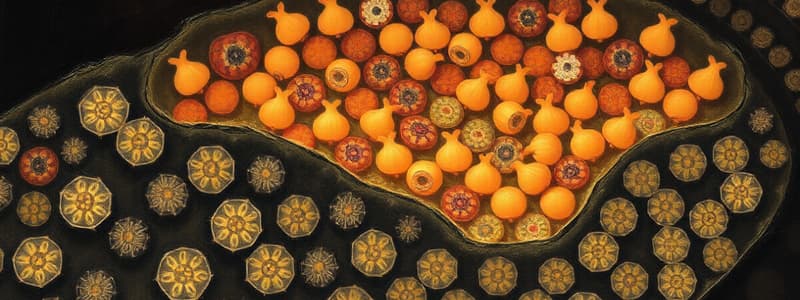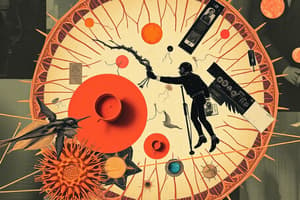Podcast
Questions and Answers
What is the key mechanism of evolution that enhances survival and reproduction?
What is the key mechanism of evolution that enhances survival and reproduction?
- Speciation
- Genetic drift
- Natural selection (correct)
- Mutation
Which level of ecological organization comes directly after 'populations' in the hierarchical structure?
Which level of ecological organization comes directly after 'populations' in the hierarchical structure?
- Species
- Individuals
- Communities (correct)
- Ecosystems
Which process is primarily responsible for converting light energy into chemical energy?
Which process is primarily responsible for converting light energy into chemical energy?
- Fermentation
- Decomposition
- Photosynthesis (correct)
- Cellular respiration
In the taxonomic classification system, which group is the broadest category?
In the taxonomic classification system, which group is the broadest category?
Which branch of biology focuses on the study of heredity?
Which branch of biology focuses on the study of heredity?
What is considered the fundamental unit of life?
What is considered the fundamental unit of life?
Which of the following is NOT a characteristic of living organisms?
Which of the following is NOT a characteristic of living organisms?
Which type of cells lack a nucleus and membrane-bound organelles?
Which type of cells lack a nucleus and membrane-bound organelles?
What is the primary function of mitochondria in eukaryotic cells?
What is the primary function of mitochondria in eukaryotic cells?
What are genes primarily responsible for?
What are genes primarily responsible for?
Which process is a form of sexual reproduction?
Which process is a form of sexual reproduction?
What is the focus of the field of ecology?
What is the focus of the field of ecology?
Which component is NOT considered part of an ecosystem?
Which component is NOT considered part of an ecosystem?
Flashcards
Evolution
Evolution
The process by which populations of organisms change over generations due to variations in traits and the environment.
Natural Selection
Natural Selection
A key mechanism of evolution where organisms with traits better suited to their environment are more likely to survive and reproduce, passing on those advantageous traits.
Classification
Classification
The systematic arrangement and naming of organisms into hierarchical groups based on shared characteristics.
Photosynthesis
Photosynthesis
Signup and view all the flashcards
Cellular Respiration
Cellular Respiration
Signup and view all the flashcards
What is the fundamental unit of life?
What is the fundamental unit of life?
Signup and view all the flashcards
What is Biology?
What is Biology?
Signup and view all the flashcards
What is organization in living organisms?
What is organization in living organisms?
Signup and view all the flashcards
What is Metabolism?
What is Metabolism?
Signup and view all the flashcards
What is Growth and Development?
What is Growth and Development?
Signup and view all the flashcards
What is Adaptation?
What is Adaptation?
Signup and view all the flashcards
What is Homeostasis?
What is Homeostasis?
Signup and view all the flashcards
What is Evolution?
What is Evolution?
Signup and view all the flashcards
Study Notes
Introduction to Biology
- Biology is the scientific study of life and living organisms, including their structure, function, growth, origin, evolution, and distribution.
- It encompasses a vast field, including subdisciplines like botany, zoology, microbiology, genetics, and ecology.
- The fundamental unit of life is the cell.
- All living organisms are composed of cells, which perform essential life functions.
Characteristics of Living Organisms
- Living organisms share key characteristics distinguishing them from non-living things:
- Organization: Complex, highly structured.
- Metabolism: Acquire and use energy for life processes.
- Growth and development: Cells multiply, organisms grow and mature.
- Adaptation: Organisms adjust to their environments, often across generations.
- Response to stimuli: React to internal or external changes.
- Reproduction: Produce offspring, either sexually or asexually.
- Homeostasis: Maintain a relatively stable internal environment.
- Evolution: Gradual change in populations over generations.
Cell Structure and Function
- Cells are the basic structural and functional units of life.
- Prokaryotic cells (bacteria and archaea) lack a nucleus and membrane-bound organelles.
- Eukaryotic cells (plants, animals, fungi, and protists) have a nucleus and membrane-bound organelles, enabling compartmentalized functions.
- Key organelles include the nucleus, mitochondria, ribosomes, endoplasmic reticulum, Golgi apparatus, and vacuoles.
- Specific structures enable varied functions, from energy production to protein synthesis to waste removal.
Genetics
- Genetics studies heredity and inherited trait variations.
- DNA (deoxyribonucleic acid) is the hereditary material in most organisms.
- Chromosomes, containing DNA and proteins, carry genetic information.
- Genes are DNA segments coding for proteins, expressing traits.
- Meiosis and mitosis are crucial cell division processes for reproduction and growth.
Ecology
- Ecology studies interactions between organisms and their environment.
- Ecosystems are complex systems combining biotic (living) and abiotic (non-living) components.
- Ecological principles include energy flow, nutrient cycling, biodiversity, and population dynamics.
- Key ecological levels are individuals, populations, communities, and ecosystems.
Evolution
- Evolution is the process of population change over generations.
- Natural selection is a key mechanism—organisms with advantageous traits survive and reproduce more successfully.
- Genetic variation and mutations contribute significantly to life's diversity.
- Evolutionary theory explains the unity and diversity of life on Earth.
Classification
- Organisms are classified into hierarchical groups based on shared characteristics.
- The taxonomic system, from broadest to narrowest, includes Domain, Kingdom, Phylum, Class, Order, Family, Genus, and Species.
- This system systematically arranges and names organisms.
Important Biological Processes
- Photosynthesis, used by plants and some other organisms, converts light energy into chemical energy (sugars).
- Cellular respiration breaks down food molecules to release energy.
- These fundamental processes are crucial for organism survival.
Branches of Biology
- Various specialties exist within biology:
- Botany (plant study)
- Zoology (animal study)
- Microbiology (microorganism study)
- Genetics (heredity study)
- Ecology (organism-environment interactions)
- Physiology (living organism functions)
- Molecular Biology (biomolecule structure and function)
Biomolecules
- Living organisms comprise diverse biomolecules: carbohydrates, lipids, proteins, and nucleic acids.
- These molecules play vital roles, from forming cell structures to catalyzing reactions.
Studying That Suits You
Use AI to generate personalized quizzes and flashcards to suit your learning preferences.




